Teen Driving Restrictions in New York: Complete Guide for 16, 17 & 18 Year Olds (2025)
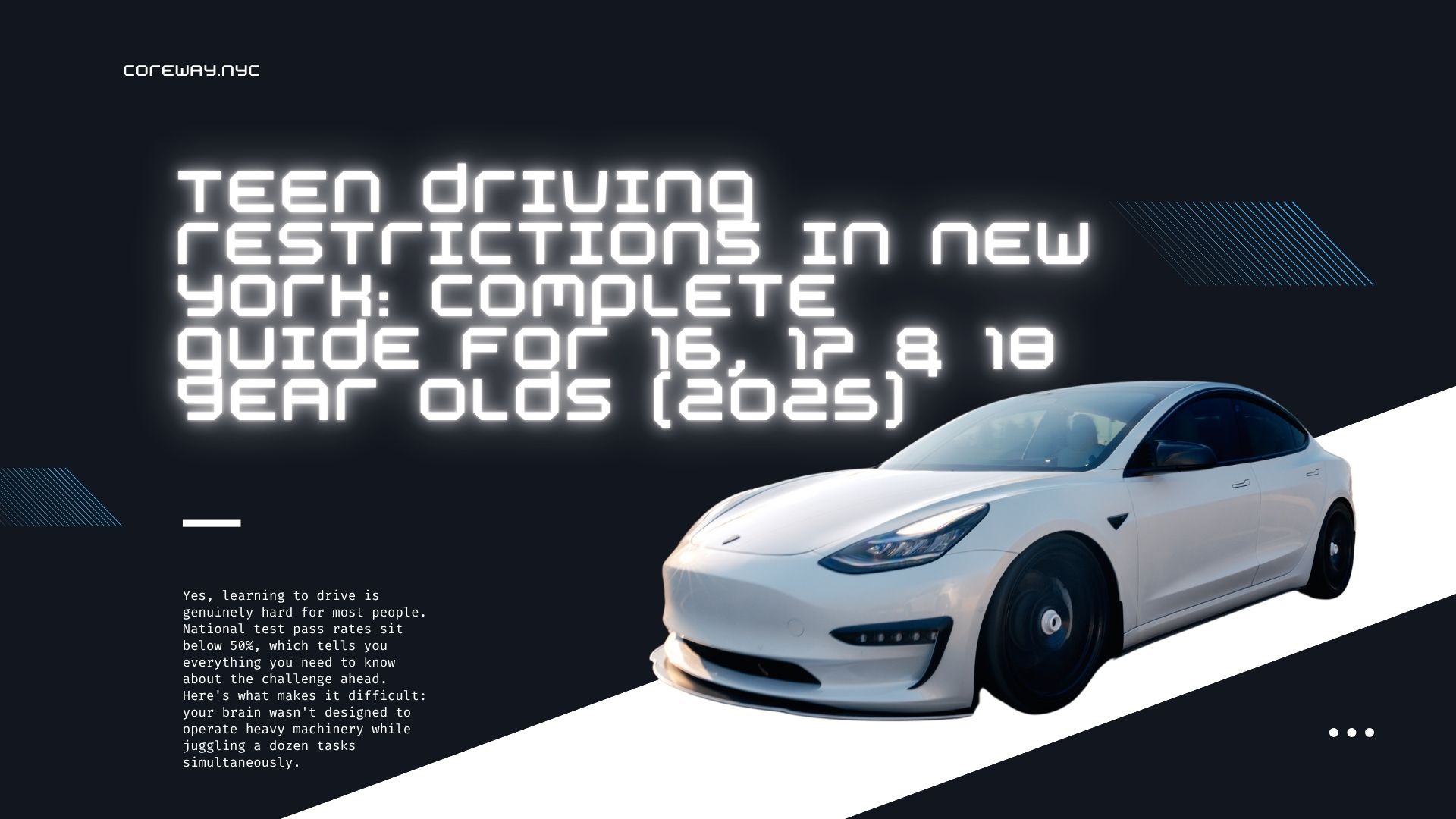
Table of Contents
- Understanding New York's Graduated Driver Licensing (GDL) System
- 16 Year Old Driving Restrictions in New York
- 17 Year Old Driving Restrictions in New York
- 18 Year Old Driving Restrictions in New York
- Passenger and Seatbelt Restrictions for All Teen Drivers
- Cell Phone and Electronic Device Restrictions
- Penalties and Violations for Teen Drivers
- Driving Out of State with a NY Junior License
- Teen Driving Safety Statistics in New York
- How Coreway Driving School Prepares Teens for Safe Driving
- Tips for Parents of Teen Drivers
- Common Mistakes Teen Drivers Make
- What to Do After a Teen Driving Accident
- Ready to Start Your Teen's Driving Journey?
At 16 in New York, you need a licensed adult in the passenger seat-always. At 17, you might drive freely upstate between 5 AM-9 PM, but you can't drive in NYC at all unless you've upgraded to a senior license through driver's ed. At 18, all restrictions end.
Here's the catch: a 17-year-old with a junior license can drive to work alone in Albany but can't drive to the store in Brooklyn without supervision. Same license, different rules based on geography. Motor vehicle crashes kill more teens aged 16-17 than any other cause, which is why New York's graduated system exists-it cuts teen accidents in half.
Understanding New York's Graduated Driver Licensing (GDL) System
New York's GDL has three stages: learner's permit (always supervised), junior license (limited unsupervised driving with restrictions), and senior license (full privileges). The system forces inexperienced drivers to build skills gradually instead of getting full freedom immediately after passing a road test.
|
Stage |
Minimum Age |
Duration |
Key Requirements |
Supervision Required |
|
Learner's Permit (Class DJ/MJ) |
16 years |
6 months minimum |
Pass written test and vision exam; 50 hours supervised practice (15 at night) |
Always |
|
Junior License (Class DJ/MJ) |
16½ years |
Until age 17 (with driver's ed) or 18 |
Pass road test and pre-licensing course; regional restrictions apply |
Varies by region and time |
|
Full License (Class D/M) |
17 years (with completion certificate) or 18 years |
Ongoing |
Complete approved driver education course (if under 18) |
Never |
16 Year Old Driving Restrictions in New York
Turning 16 opens the door to driving, but it's just the first step. At this age, New York allows you to apply for a learner's permit, which comes with substantial restrictions while you're learning the basics.
Getting Your Learner's Permit at 16
The moment you turn 16, you can apply for a learner's permit with your parent's or guardian's written permission. You'll need to visit a DMV office with the required documentation.
Bring several documents to prove your identity and residence. The DMV requires proof of identity (like your birth certificate or passport), your Social Security card, and proof of residency in New York. Many teens use a school transcript or utility bill in their parent's name to establish residency.
Before receiving your permit, you must pass two tests at the DMV. The vision exam ensures you can see well enough to drive safely. The written test covers traffic laws, road signs, and safe driving practices. Many students find that taking a pre-licensing course helps them prepare thoroughly for both the written exam and future stages. You might want to learn more about what age you can take driver's ed to plan your timeline.
Learner's Permit Restrictions at Age 16
Once you have your learner's permit, you can legally drive, but only under specific conditions. A licensed driver who is at least 21 years old must always be in the front passenger seat. This supervising driver needs to hold a valid license for the type of vehicle you're operating.
During daytime hours (5 AM to 9 PM), your supervising driver can be any licensed adult age 21 or older. Between 9 PM and 5 AM, New York law is stricter. During these nighttime hours, you can only drive if supervised by your parent, legal guardian, person in loco parentis (someone acting in place of your parent), or a certified driver education teacher or driving school instructor.
The passenger restrictions are equally important. You cannot have more than one passenger under age 21 in the vehicle unless they're members of your immediate family. Every single person in the car must wear a seat belt-one person per belt. If you're transporting young children, you need to follow New York's child safety seat laws precisely.
There are also specific places where learner's permit holders cannot drive, regardless of supervision:
- Within any park in New York City
- On bridges or tunnels controlled by the Triborough Bridge and Tunnel Authority
- On the Cross County, Hutchinson River, Saw Mill River, or Taconic State parkways in Westchester County
- In any DMV road test area
These restrictions keep you away from the most challenging driving environments while you're still building basic skills. Many families find that starting with driving lessons for beginners in quieter neighborhoods helps build confidence before tackling busier roads.
Geographic Restrictions for 16 Year Olds
New York divides the state into three regions for GDL purposes: Upstate New York (any county north of the New York City border), New York City (the five boroughs), and Long Island (Nassau and Suffolk counties). At 16 with a learner's permit, you face the same supervised-driving requirements regardless of which region you're in. The real geographic differences become important once you advance to a junior license.
|
Supervising Driver Requirements |
Daytime (5 AM - 9 PM) |
Nighttime (9 PM - 5 AM) |
|
Who can supervise |
Any licensed driver age 21+ |
Parent, guardian, person in loco parentis, or certified instructor only |
|
Passenger limit |
1 non-family member under 21 |
1 non-family member under 21 |
|
Seat belt requirement |
Everyone must be belted |
Everyone must be belted |
You'll need to log at least 50 hours of supervised driving practice before you can take your road test. Fifteen of those hours must be completed at night to ensure you're comfortable driving after dark.
17 Year Old Driving Restrictions in New York
At 17, your driving privileges can expand or remain heavily restricted, depending on where you live and whether you've completed the required driver education course. Geographic differences become particularly relevant at this age.
Transitioning to a Junior Driver's License at 16½-17
You can apply for a junior license as young as 16½, as long as you've held your learner's permit for at least six months without any suspensions.
The application process requires your parent or guardian to sign the application form. You'll also need to present a completed driving log showing at least 50 hours of supervised practice, with 15 of those hours completed during nighttime driving. The state requires genuine documentation of your practice time.
Before you can schedule your road test, you must complete a state-approved pre-licensing course. This is different from a full driver education program, though many students take both. The pre-licensing course covers defensive driving, road rules, and accident prevention. Many students take their 5-hour driving class online for convenience.
When you're ready, you'll schedule and pass a road test at the DMV. The examiner will evaluate your ability to control the vehicle, follow traffic laws, and make safe decisions. For students who want extra preparation, services offering a car for road test can reduce stress. Check out our guide on preparing for your driving test if you're nervous about the exam.
Keep careful records of your supervised driving hours. The DMV may verify your log, and falsifying these records can delay your license or result in penalties. Many parents keep a dedicated notebook in the car to log each practice session immediately.
Junior License Restrictions by Region
Your junior license privileges depend entirely on which of New York's three regions you're driving in. What's allowed in one area might be completely prohibited in another.
Upstate New York (Counties North of NYC)
If you live upstate, your junior license offers the most freedom. Between 5 AM and 9 PM, you can drive without any supervision. You're allowed to have one passenger under age 21 who isn't a family member, or multiple passengers if they're your immediate family members (siblings, for example). Every passenger must wear a seat belt, and all child safety seat laws apply if you're transporting young children.
Between 9 PM and 5 AM, the rules tighten. You can only drive unsupervised during these nighttime hours if you're traveling directly between your home and either your place of employment or a qualifying school course. "Employment" means a place where you're paid to work on a regularly scheduled basis-you cannot drive during work hours or as part of job duties like making deliveries. You must carry a completed Certificate of Employment form (MV-58A) as proof.
A "school course" means instruction, education, or training that's licensed or approved by a state agency, or training conducted by the U.S. Armed Forces. This does NOT include extracurricular activities, sports practices, or social events, even if they're school-related. If you're not earning academic credit, it doesn't qualify.
For any other nighttime driving, you must be supervised by your parent, guardian, person in loco parentis, or a certified driver education teacher or driving school instructor. The supervising driver must be at least 21 years old and hold a valid license for the vehicle type. Only your supervisor can sit in the front passenger seat, and you're still limited to one non-family passenger under 21.
New York City (Five Boroughs)
New York City has the strictest restrictions of all three regions. If you have a Class DJ or MJ junior license, you cannot drive within the five boroughs of New York City under any circumstances. No exceptions exist for work, school, or any other reason.
This complete prohibition recognizes the challenges of driving in NYC-heavy traffic, aggressive drivers, complex intersections, and constant pedestrian activity. The state has decided that junior license holders aren't ready for these conditions.
If you plan to drive frequently in New York City, the state recommends delaying your road test until your 18th birthday. This gives you more time to practice with approved supervising drivers in vehicles equipped with dual controls (dual brakes), which most professional driving schools use.
There is one exception: this NYC prohibition does not apply to 17-year-olds who have completed a State Education Department-approved Driver and Traffic Safety Education Course and upgraded to a Class D adult license.
Long Island (Nassau & Suffolk Counties)
Long Island sits between upstate and NYC in terms of restrictions. The general rule is that you must be supervised whenever you're driving in Nassau or Suffolk counties. Your supervising driver can be your parent, guardian, person in loco parentis, someone your parent or guardian has authorized in writing to supervise you, or a certified driver education teacher or instructor.
Long Island offers some exceptions during specific hours for specific purposes. Between 5 AM and 9 PM, you can drive unsupervised directly between your home and:
- Your place of employment (with proper documentation)
- A state-approved cooperative work-study educational program
- An approved program for credit in a post-secondary institution
- A state-approved registered evening high school
- Farm employment
- An approved driver education course
Between 9 PM and 5 AM, the exceptions narrow. You can only drive unsupervised to and from:
- A state-approved cooperative work-study educational program
- An approved program for credit in a post-secondary institution
- A state-approved registered evening high school
- Farm employment
- An approved driver education course
Regular employment isn't included in the nighttime exceptions-that's a daytime-only privilege on Long Island.
|
Region |
Daytime Unsupervised (5 AM - 9 PM) |
Nighttime Unsupervised (9 PM - 5 AM) |
Passenger Limit |
|
Upstate NY |
Yes, unrestricted |
Only home-to-work or home-to-school (with proof) |
1 non-family under 21 |
|
NYC (5 Boroughs) |
No, always supervised |
No, always supervised |
1 non-family under 21 (when supervised) |
|
Long Island (Nassau/Suffolk) |
Only for work, educational programs, farm employment |
Only for educational programs, farm employment |
1 non-family under 21 (when supervised) |
For students looking to gain more experience with professional guidance, consider driver training in Brooklyn which can help you navigate these complex regional requirements and build the skills you'll need for safe, independent driving.
Getting an Unrestricted License at 17
New York offers an opportunity for motivated 17-year-olds. You don't have to wait until 18 to get full driving privileges if you're willing to complete an approved driver education course.
To qualify for a Class D senior license at age 17, you must complete a State Education Department-approved Driver and Traffic Safety Education Course. These comprehensive courses cover defensive driving techniques, advanced road rules, and real-world decision-making skills that go beyond the basic pre-licensing class.
Upon completing the course, your instructor will give you a Student Certificate of Completion (form MV-285). This certificate is your ticket to unrestricted driving. Take it to any DMV office along with your current junior license, and the DMV will exchange them for a senior license. You must physically surrender both the certificate and your junior license to receive the upgrade.
Simply carrying the completion certificate doesn't change anything. You remain subject to all junior license restrictions until you physically exchange the certificate at the DMV for a senior license. Having the certificate in your wallet doesn't give you permission to ignore curfews or drive in NYC.
Once you have your Class D senior license at 17, you have unrestricted driving privileges throughout New York State. You can drive in all five boroughs of New York City, at any time of day or night, and with as many passengers as your vehicle is designed to carry safely. The geographic and time-based restrictions that limit junior license holders don't apply to you.
Many families find this path worthwhile because it opens up opportunities for work, school activities, and social independence a full year earlier than waiting until 18. If you're considering this option, learn more about junior drivers licenses and what the upgrade process entails.
18 Year Old Driving Restrictions in New York
When you turn 18, New York's graduated licensing system ends automatically. If you hold a junior license and meet all other requirements, it transitions to a senior Class D or Class M license on your 18th birthday without any additional paperwork or testing.
At 18, you face no geographic restrictions, no curfew requirements, and no passenger limitations. You can drive anywhere in New York State at any time with any number of passengers (as long as they fit safely in your vehicle with proper seat belts).
The difference between getting unrestricted privileges at 17 versus waiting until 18 comes down to whether you've completed driver education. Those who complete an approved course at 17 gain a full year of unrestricted driving. Those who don't must wait until 18, but they avoid the cost and time commitment of the additional coursework.
At 17 (with driver's ed): Full NYC driving privileges immediately, can work any hours, full social freedom, one year head start on building driving experience, cost of driver's ed course required
At 18 (without driver's ed): Automatic upgrade on birthday, no additional course fees, same privileges but one year later, missed year of unrestricted driving experience
Even with full driving privileges, 18-year-olds should continue practicing safe driving habits developed during earlier stages. The restrictions may lift, but the need for defensive driving, attention to road conditions, and respect for other drivers remains constant.
Call Us Today 9AM-10PM
Or fill out the form 24/7
Our team is here to guide you with promotions, instructor availability, and the best training package for you.
Passenger and Seatbelt Restrictions for All Teen Drivers
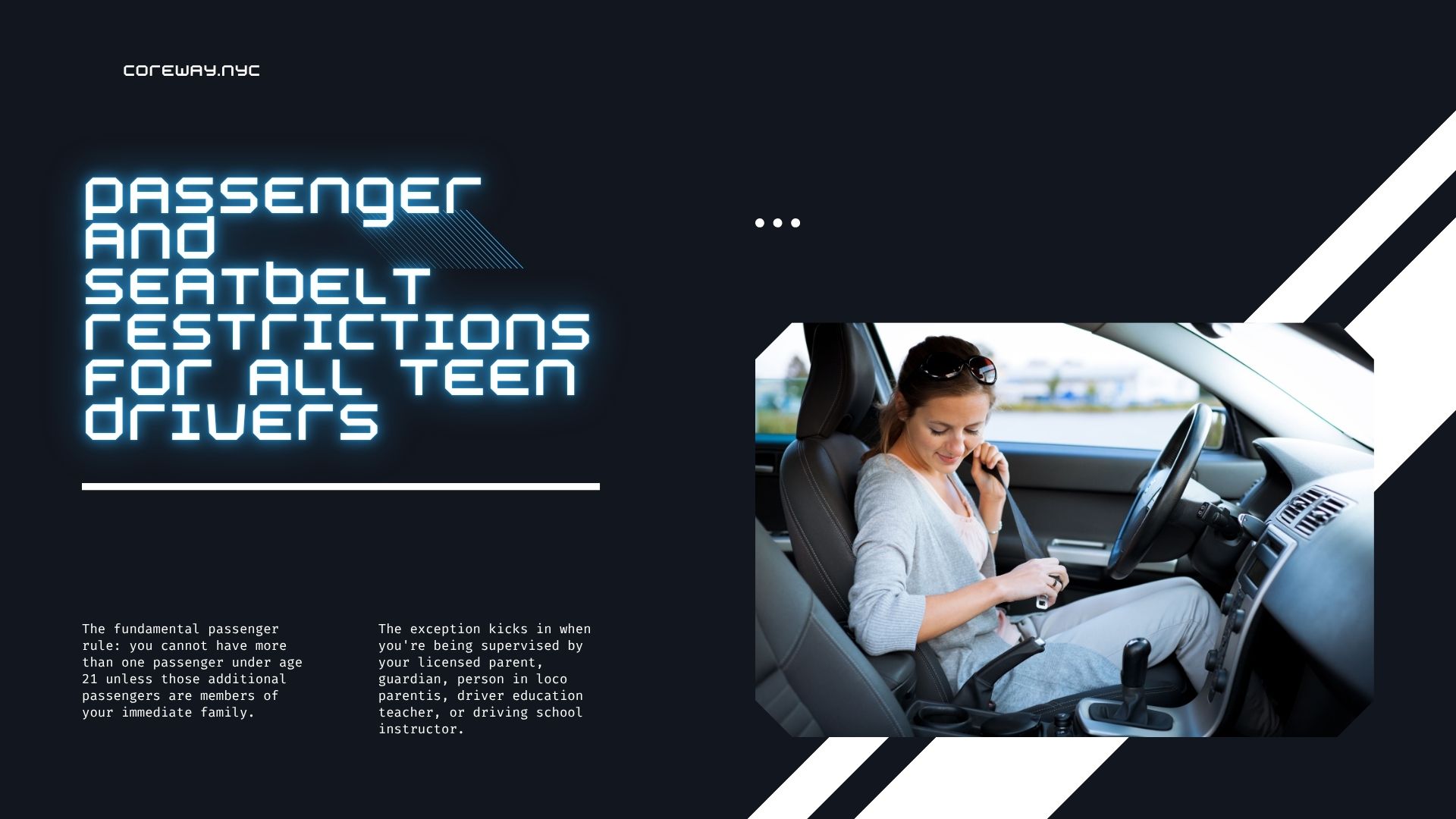
Regardless of your age or license type, New York enforces strict rules about passengers and seat belt use. These requirements apply to everyone from learner's permit holders through junior license drivers.
The fundamental passenger rule: you cannot have more than one passenger under age 21 unless those additional passengers are members of your immediate family. This means you can drive your younger siblings, but you can't pile three friends into your car for a trip to the mall. The restriction exists because research shows that teen drivers face higher crash risks when carrying multiple teen passengers-each additional passenger increases the likelihood of a fatal crash.
The exception kicks in when you're being supervised by your licensed parent, guardian, person in loco parentis, driver education teacher, or driving school instructor. In that case, you can have multiple passengers under 21 as long as your supervising driver is present. This allows families to transport multiple children and permits driving students to practice with friends in the car under professional supervision.
New York's seat belt laws are absolute. Every passenger in the vehicle must wear a seat belt, with one person per belt. If your car has five seat belts, you can have a maximum of five occupants, each properly belted. Many teens don't realize they can be ticketed for their passengers' seat belt violations, so it's your responsibility to ensure everyone buckles up before you start driving.
When transporting young children, additional requirements apply:
- Children under age 4 must ride in a federally-approved child safety seat appropriate for their size
- Children weighing more than 40 pounds must use a proper child restraint system such as a booster seat
- Until their 8th birthday, children must use a proper child restraint system
- Children more than 4 feet 9 inches tall are allowed to use a regular seat belt and shoulder harness
These rules apply whether the children are your siblings, relatives you're babysitting, or anyone else under your care. Violating child safety seat laws can result in fines and points on your driving record. Understanding who can teach you to drive can also help clarify the responsibilities that come with being behind the wheel.
Cell Phone and Electronic Device Restrictions
Drivers under 18 cannot use any electronic device while operating a vehicle-hand-held phones, hands-free devices, or GPS. This applies even when stopped at red lights.
First conviction: 120-day license suspension Second conviction (within 6 months): Minimum 1-year license revocation
Set up navigation before you start driving and use voice-only, or have a passenger navigate. The penalties aren't worth the risk.
Penalties and Violations for Teen Drivers
Junior license holders face 60-day suspension for one serious traffic violation (3+ points) or two other violations. If violations occur within six months after license restoration, you get a 60-day revocation instead of suspension.
Suspension is temporary-your license returns automatically when the period ends. Revocation means your license is cancelled and you must reapply, retake tests, and pay new fees.
DUI/DWI consequences: Immediate license suspension, criminal charges, mandatory education programs, substantial fines, possible jail time, and a permanent criminal record affecting college admissions, scholarships, and job opportunities. Insurance rates can triple or quadruple. New York has zero-tolerance for underage drinking and driving.
|
Violation Type |
First Offense |
Second Offense (within 6 months) |
|
Cell phone/texting |
120-day suspension |
1-year minimum revocation |
|
1 serious violation (3+ points) |
60-day suspension |
60-day revocation |
|
2 other violations |
60-day suspension |
60-day revocation |
|
DUI/DWI |
Immediate suspension, criminal charges |
Longer suspension, higher fines, criminal record |
Call Us Today 9AM-10PM
Or fill out the form 24/7
Our team is here to guide you with promotions, instructor availability, and the best training package for you.
Driving Out of State with a NY Junior License
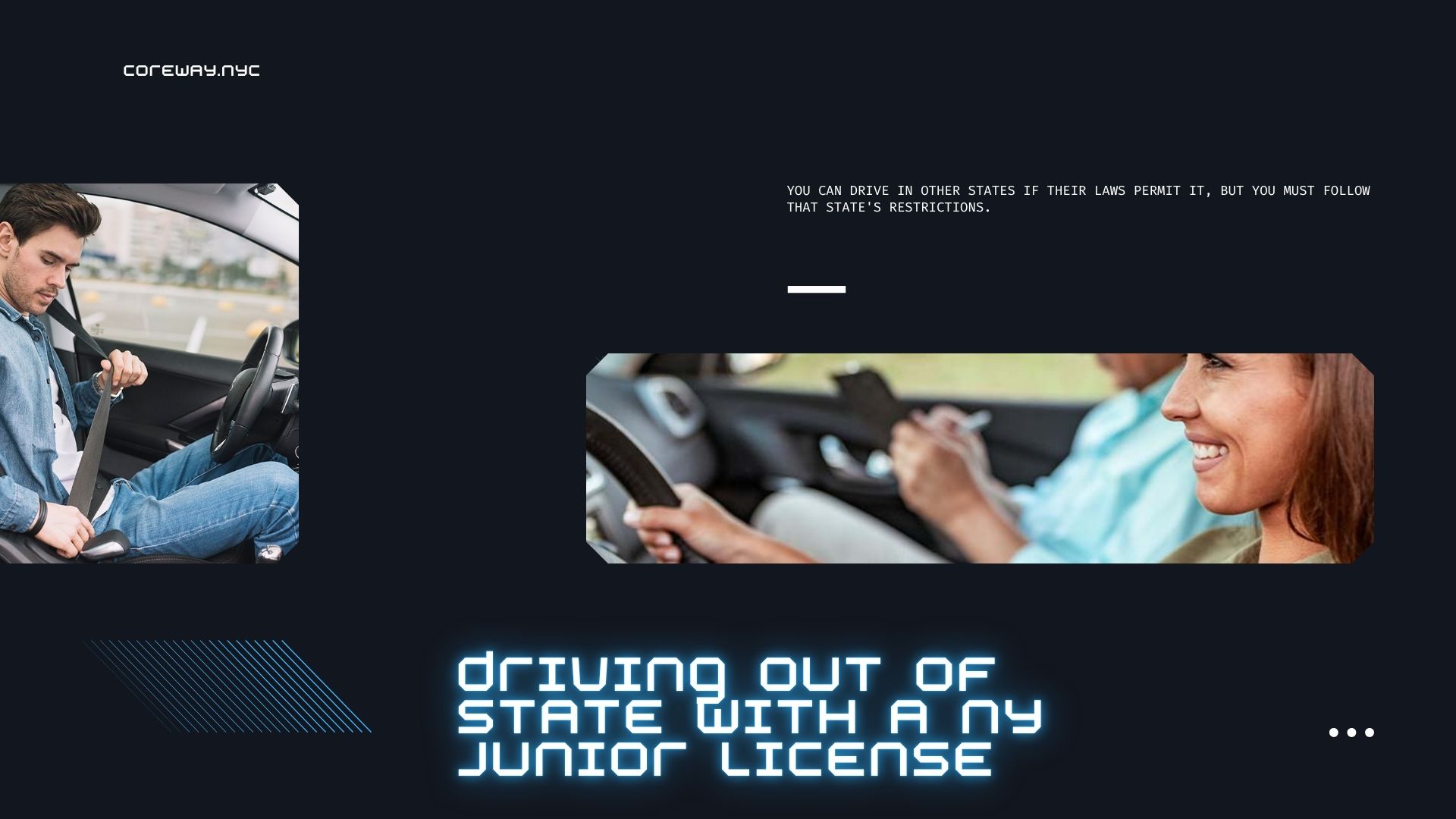
You can drive in other states if their laws permit it, but you must follow that state's restrictions. Each state has different rules about recognizing out-of-state junior licenses. Contact the motor vehicle authority in any state you plan to visit before traveling.
Drivers under 16 cannot drive in New York State with any out-of-state license. Drivers 16-17 with out-of-state junior licenses must follow both their home state's restrictions and New York's restrictions.
Teen Driving Safety Statistics in New York
Teen drivers in New York are involved in thousands of accidents annually, resulting in 3,500+ emergency room visits, nearly 200 hospitalizations, and about 16 deaths. Average hospitalization costs exceed $53,000.
Teen drivers vs. older drivers:
- Unsafe speed: 21% vs. 10% (teens 2x more likely)
- Driver inexperience: 8% vs. <1% (teens 8x+ more likely)
- Failure to yield: 6% vs. 3% (teens 2x more likely)
- Distracted driving: 4% vs. 5% (similar rates)
- Impaired driving: 1% vs. 7% (teens less likely due to zero-tolerance enforcement)
How Coreway Driving School Prepares Teens for Safe Driving
Coreway offers state-approved driver education courses meeting all requirements for unrestricted Class D licenses at age 17. We provide real-world training in Brooklyn traffic, preparation for the 50+ required supervised hours, specialized road test preparation, and vehicles for your DMV test.
Our program includes one-on-one instruction, flexible scheduling, parent consultations, and defensive driving techniques. We serve students throughout Brooklyn with driver training tailored to NYC conditions.
Contact Coreway Driving School to schedule your first lesson.
Tips for Parents of Teen Drivers
- Clearly explain and enforce all restrictions based on license type and location
- Practice in challenging conditions: busy highways, rain, night, parallel parking, complex intersections
- Model safe driving-teens copy what you do, not what you say
- Create a parent-teen driving contract with expectations beyond state requirements
- Discuss consequences of violations: legal penalties, insurance increases, license suspension
- Review routes before approving solo trips during early months
- Set rules for cell phone storage (trunk, glove box, off)
- Practice emergency maneuvers in safe environments
- Extend supervised period beyond minimums if your teen needs more practice
- Remember: teen brains aren't fully developed yet, especially areas controlling judgment and risk assessment
Common Mistakes Teen Drivers Make
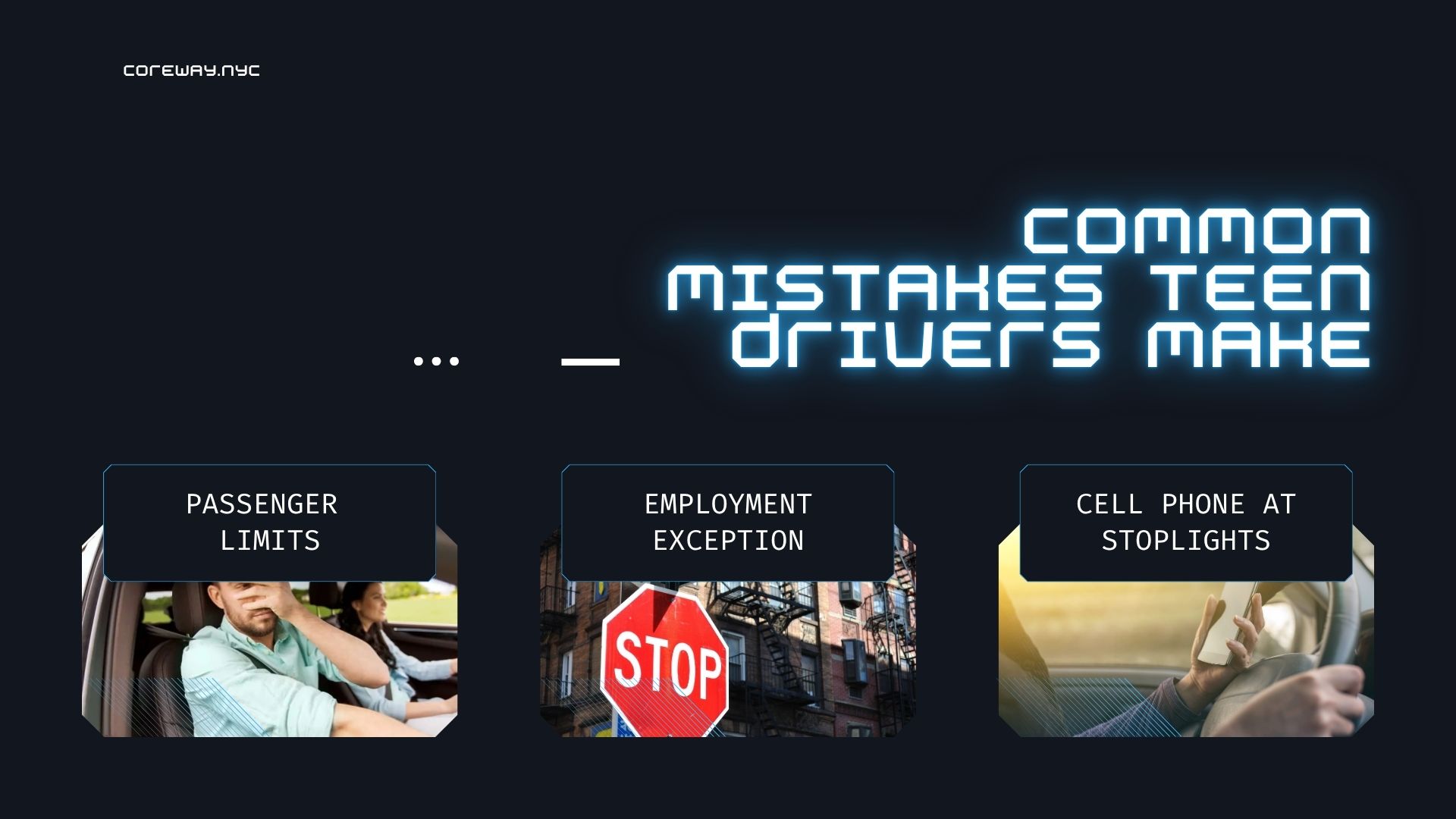
Passenger limits: One non-family passenger under 21 applies everywhere, not just "sometimes." Multiple friends require adult supervision.
Geographic confusion: Junior licenses work differently in NYC (no driving), Long Island (mostly supervised), and upstate (most freedom). Living near a border doesn't change the rules.
Employment exception: Only covers direct home-to-work travel. No stops, errands, or picking up friends. Must carry MV-58A form.
"School course" misunderstanding: Sports, clubs, rehearsals don't qualify. Only academic credit courses or approved formal training count.
Cell phone at stoplights: You're still "operating" the vehicle when stopped. The ban applies continuously while driving.
Missing documentation: No MV-58A for work trips or no completion certificate when claiming senior license eligibility = violations and delays.
What to Do After a Teen Driving Accident
- Call 911 if anyone is injured
- Move vehicles to safety if possible, turn on hazards
- Take photos of all vehicles, damage, scene, road conditions
- Exchange information: names, addresses, phone numbers, license numbers, insurance, plates
- Get witness contact information
- Call parents immediately
- Don't admit fault or apologize-keep communication factual
- Get medical attention within 24 hours even if you feel fine
- Get police report number if officers respond
- Keep all documentation: medical bills, repair estimates, correspondence
- Contact attorney for injuries, major damage, or fault disputes
Insurance rates will increase significantly after an at-fault accident. You may face traffic violations or points depending on the cause. attorney experienced in teen driving cases and car accident claims if the accident involves injuries, disputes about fault, or potential license consequences. Early legal guidance can make a significant difference in the outcome.
Ready to Start Your Teen's Driving Journey?
Age 16: Learner's permit only, always supervised, 50 hours practice required (15 at night).
Age 17: Junior license with regional restrictions (upstate: daytime freedom, NYC: no driving, Long Island: limited exceptions) OR unrestricted senior license if you complete driver's ed and submit MV-285 certificate.
Age 18: All restrictions end automatically.
The fastest path to unrestricted driving is completing a state-approved driver education course at 17. Without it, you wait until 18.
Coreway Driving School offers state-approved courses that qualify you for a senior license at 17, plus road test preparation and test day vehicles. Our instructors train teens in real Brooklyn traffic conditions, preparing you for safe, independent driving.
Contact Coreway Driving School to schedule your first lesson and start your path to a driver's license.
Call Us Today 9AM-10PM
Or fill out the form 24/7
Our team is here to guide you with promotions, instructor availability, and the best training package for you.
Frequently Asked Questions
-
When can my teen drive alone in New York?
With a junior license at 16½–17: In upstate NY, unsupervised between 5 AM–9 PM (nighttime only for work/school with proof). On Long Island, only for approved activities (work, educational programs). In NYC, never without supervision.
-
How many supervised hours are required before the road test?
50 hours total, with at least 15 completed at night. Document these hours — the DMV may verify your log.
-
Can a 17-year-old drive after 9 PM in NYC?
No, unless they have a Class D senior license (obtained by completing driver’s ed and exchanging the MV-285 certificate). Junior license holders cannot drive in NYC at any time.
-
Is driver’s education mandatory in New York?
Not for a junior license, but required to get an unrestricted senior license at age 17. Without it, you must wait until 18 for full privileges.
-
What happens if my teen violates curfew or passenger restrictions?
Traffic tickets, fines, points on license, and potential 60-day suspension (one serious violation or two other violations). Insurance rates rise. A second violation within six months of restoration causes a 60-day revocation.
-
Can my teen drive friends to school?
Only with one non-family passenger under 21, or with adult supervision. Multiple friends require a supervising parent, guardian, or instructor in the car.
-
What’s the difference between suspension and revocation?
Suspension = temporary — license automatically restored after the period ends. Revocation = license cancelled entirely — you must reapply and may need to retake tests.
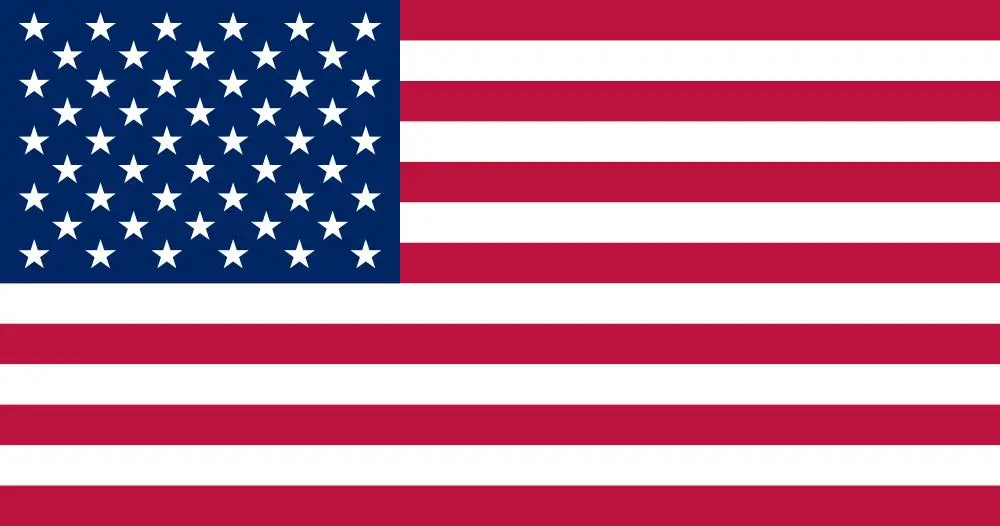 English
English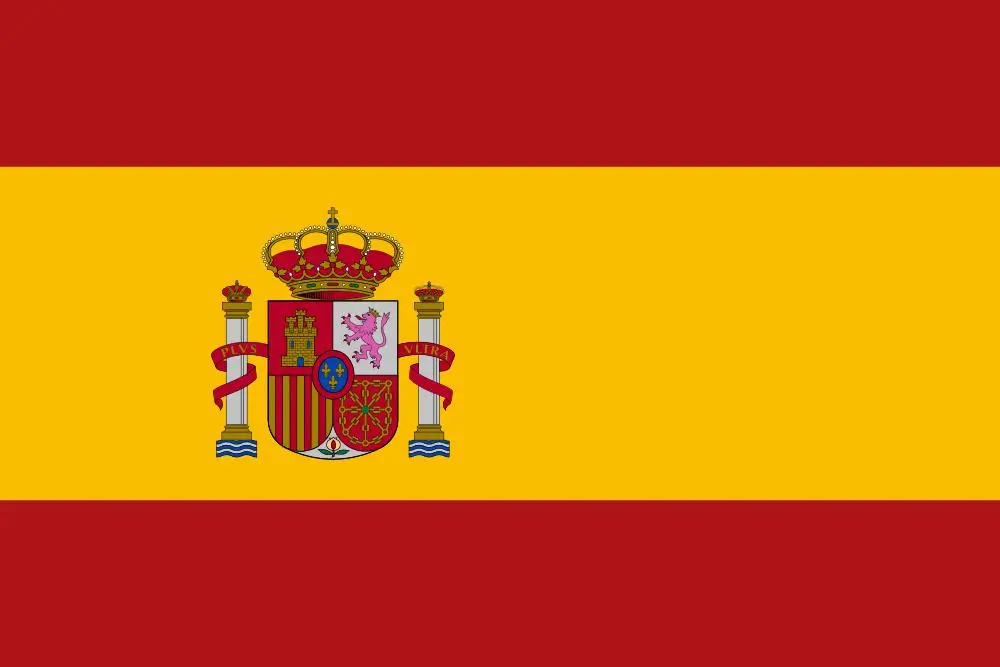 Spanish
Spanish 

